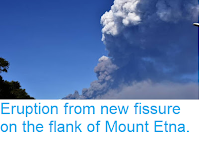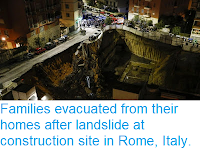A tourist has died and another has been injured following an eruption on Stromboli, a volcanic island off the east coast of southern Italy, to the north of Sicily. The tourists were hiking on the mountain on Wednesday 3 July 2019, when the volcano erupted suddenly, producing an ash cloud that swept down towards the village of Ginostra, which has now been evacuated. as well as lava flows on the side of the mountain. The tourist were apparently hit by fragments of rock thrown from the volcano's crater. Such eruptions are extremely unusual on Stromboli, with the last happening in 2007. This is despite the volcano being arguably the most active in Europe, producing many small eruptions each day, typically in the form of small lava fountains that do not leave the crater and which are a popular tourist attraction, such constant small eruptions are known as 'Stombolian' eruptions when encountered on other volcanoes.
Eruption on Stromboli on 3 July 2019. EPA.
Stromboli has been in more-or-less constant eruption since at least Roman times,
and is thought to be about 5000 years old, though it is not generally
considered dangerous if not approached closely; there are three
settlements on the island, all less than three kilometres from the
summit. Stromboli is noted for frequent small explosive eruptions, which
through lava bombs, ash and incandescent rock fragments out of the
crater, a type of eruption known by vulcanologists around the world as
'strombolian'. The summit rises 924 m above sea level.
The approximate location of Mount Stromboli. Google Maps.
Southeastern Italy lies on the edge of the Eurasian Plate, close to its
margin with Africa. The African Plate is being subducted beneath Italy
on along a margin that cuts through the island of Sicily. The African
plate is being subducted beneath Italy, and as it sinks is melted by the
friction and heat of the Earth's interior. Some of the melted material
then rises through the overlying plate fuelling the volcanoes of
southern Italy.
Map showing the tectonic plates underlying Italy and southern Europe, and the location of the l'Aquila Earthquake. Napoli Unplugged.
See also...
Follow Sciency Thoughts on Facebook.









